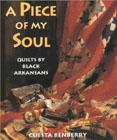A Piece of My Soul:
by Cuesta Benberry |
In her book "A Piece of my Soul", Cuesta Benberry examines the history of quilts made by black Arkansans. In several cases she follows the evolution of quilting in individual families. The quilts pictured and discussed range from everyday utility quilts to those made to be used only for special occasions. In reading this book we discover that it doesn't matter if a quilt was quickly made from scraps or painstakingly made over several months. In both cases quilters got a great deal of creative satisfaction. The handling of fabrics and trying different colors and prints in various arrangements can be a pleasure no matter what kind of quilt is being made.
Benberry makes it clear that a utilitarian scrap quilt does not indicate a lack of skill on the part of the quiltmaker. In fact some rural quilters prided on their ability to "cut by eye". Improvisational arrangements cut in this way can be uniquely stunning and attractive. You will enjoy viewing everyday quilts varying from a "Lazy Gal Strip Quilt" exuding joy in a riot of colors to others made with a mixture of traditional blocks blended together to make interesting displays. Along with the photographs of these quilts Benberry gives us a bit of history about the quilters. She shatters the myth that quilting was just a necessary chore for those women who had neither the time nor money to make a fancy traditional quilt.
But the quilts made by these African American women are certainly not limited to informal quilts. These women enjoyed many of the same patterns and fads in quilting as the general population did. Yo-yo quilts were a hit with black quilters from Kansas and they found making a Crazy Quilt as fun and challenging as any women did. Also the same traditional patterns were used by African American. It does appear though, that many of these African American quilters felt freer to improvise here and there. As a result we see some interesting color and fabric combinations and unique treatments of traditional patterns.
The most fascinating quilt described and pictured in the book is the Pine Cone or Pine Burr quilt. This is actually a three dimensional quilt made of overlapping triangles. These triangles are put in a circular pattern starting at the center giving the look of a pine cone. Benberry points out, "From early to late twentieth century, the Pine Cone quilt was popular among southern African American quilters". (p11) These unique quilts were such a hit with black Americans that they continued to make them many years beyond the time other quilters were making them. An example of a Pine Burr Quilt can be seen here.
We know that quilt names vary based on factors like the period of time or region where the quilt was made. The book contains of a good example of this in regards to the traditional Grandmother's Fan pattern. In the early twentieth century many rural southern blacks called this pattern Rooster Tail. Benberry explains that the fans these women were familiar with were flat cardboard fans quite unlike the fans the pattern was named after. For these quilters the pattern looked much more like a rooster's tail.
Benberry's acute eye and artistic sense helps us notice such intriguing touches as the one used by a woman who made her quilt using the flyfoot pattern but because of her choices of fabric combinations each block is so unique that the quilt looks likes a sampler of several block patterns. A luxurious wool log cabin made of suiting scraps captivates us with interesting twists and turns in the shadings. I soon discovered that one glance at the picture of a quilt in this book is not enough as I returned again and again to each photograph as Benberry described and details of the quilt. I know you will enjoy this book as much as I did.
© 2004 Judy Anne Johnson Breneman (Do not reproduce any material from this site without permission.)
Reference:
An Interactive Version of "A Piece of My Soul: Quilts by Black Arkansans"
from The Old State House Museum in Little Rock, Arkansas
